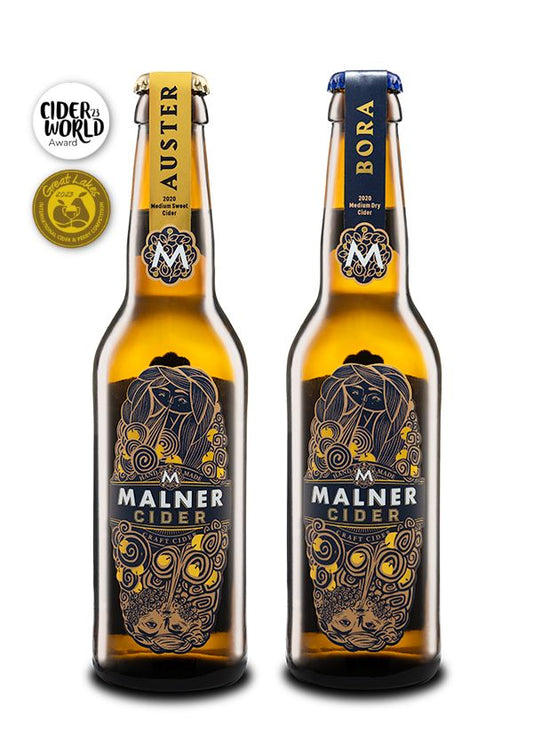England is the largest cider producer in Europe, experiencing a renaissance in the 21st century with an increasing variety of producers, brands, and consumer interest.
That's why in February 2023, we took a short trip to England to visit various cider producers.
History
Cider holds a special place in English drinking culture. Its history dates back to the Romans, with apples playing an important role in the development of the drink. Historically, the English have always been more cider drinkers than wine drinkers, though this doesn’t mean they don’t appreciate wine. The conditions for growing vines have never been on their side. Some wine was produced in ancient times, but with the onset of the mini ice age in the 15th and 16th centuries, even that came to an end, shifting interest towards beer and cider.
It is generally believed that cider production began in England around the 11th century with the arrival of the Normans, who may have introduced cultivated apple varieties. However, no records exist before the 13th century. During this time, cider was produced without documentation.
The 16th century marked a significant milestone with the first documented records of orchards and cider production methods. Two important books, Pomona by John Evelyn and Vinetum Britannicum: or a Treatise of Cider by John Worlidge, were published in 1676. These in-depth works show the immense importance cider held in the 18th century, which could be considered the golden age of cider in England. After the 18th century, beer became more popular as cider quality declined, partly due to the unsuitable varieties available at the time and tax issues.
From True Cider to Commercial Cider
Henry Percival founded Bulmers cidery in Hereford in 1887. He was the first to industrialize the cider production process in England, and his production eventually became the largest in the world, producing hundreds of millions of liters of cider. Today, Strongbow cider, part of Bulmers, still holds the largest share of global sales at 15%. The cider market evolved significantly in the 20th century. During the first 50 years, regionally grown apples were used, and traditional production methods were followed. Later, economic optimization in the production process led many to use imported juice concentrates and fewer fresh apples, where production methods had little connection to tradition.
The Unique Characteristics of English Ciders
At the heart of traditional English cider is its astringency, or higher tannin levels. This results in a deep amber color and a taste that slightly dries the mouth, contributing to the cider’s body richness. The apple varieties used for cider are highly aromatic, providing a pleasant apple aftertaste and exceptional aroma. They come in various forms, from 0.75L bottles to pub-style 0.5L bottles and draught ciders.
Challenges Facing English Cider
One of the current challenges, not limited to England, is the competition with large cider producers for defining what cider truly is. Most people don’t know or haven’t tasted the difference, assuming all ciders are the same. It's a question of quality versus quantity, and people don’t realize what they’re missing, as beautifully captured by Felix Nash in his book Fine Cider.
A new wave of smaller cider producers is currently awakening in England, setting new standards for the future of cider. We were eager to visit some of them and taste the extraordinary English ciders and perries (pear wines).
Tom Oliver's Cider
Claude's book convinced us that we would find the best perry at Tom’s. A rural road with views of orchards led us to Tom’s farm in Ocle Pychard, Herefordshire. Cider had been produced on his farm since his father’s time. Tom grows his apples, and for cider production, he also buys apples from local orchards. Today, Tom is invited to judge at cider competitions and conferences around the world.
Tom welcomed us warmly and gave us a tour of his production facility. The main difference we noticed was the varieties and the landscape where the apples are grown and processed. While our harvest season is in September and October, some varieties in England are harvested as late as December. We were particularly surprised to learn that fermentation takes place in open spaces, which are only partially enclosed, at outdoor temperatures.
He also offers barrel-aged ciders that mature in old whiskey barrels, stored in partially enclosed spaces.
At the end of the visit, Tom treated us to a tasting, and the keeved cider with lower alcohol content and the perry left a lasting impression. We also stocked up, taking some home with us.
We’ve tried many of Tom Oliver’s ciders by now, and they never disappoint. The taste of his ciders is among the best traditional English ciders.
If you ever find yourself in England, a visit to Tom Oliver’s is a must! The link to his website is here.

Little Pomona
Susanna and James Forbes, the duo behind the Little Pomona brand, started selling their ciders in 2017, though the story began a few years earlier. Susanna greeted us cheerfully at their production facility, where there is also a charming shop and tasting room, and showed us around the entire production process while treating us to local cheeses.
Little Pomona ciders are made at Brook House Farm in Bromyard, just a 15-minute drive from Tom’s and a three-and-a-half-hour drive from London.
Their vision is to work with the best possible fruit, using natural methods to produce ciders and perries with true flavor. One unique feature that stood out to us was their use of a press that allows for multi-day maceration. They make cider with natural fermentation, combining apples with pears and quinces.
Susanna also arranged a tasting of their ciders. The ciders were diverse in flavor, some even extreme and pleasantly surprising. Some reminded us of orange wines!
Susanna was a person with incredible energy, and it’s reflected in their products. We highly recommend a visit!
____
Susanna passed away in September 2024 after a long battle with cancer. Her energy and passion for craft ciders will remain in our hearts and in the hearts of the entire cider community worldwide. We will miss you! The link to her website is here.
We are also proud that Slovenian equipment is used in cider production around the world, as we saw at both Tom Oliver’s and Little Pomona.

Cider Museum
We also visited the Cider Museum in Hereford. It was opened in 1981 in the old Bulmers cider building. The museum tour reveals the history of cider making, including a 300-year-old French press, a rare collection of cider glasses, and watercolor collections of apple and pear varieties. We also walked through the cellar and viewed the old cider production line and the cooper’s workshop.
The museum also hosts an international cider and perry competition, which has been running since the early 1980s. The link to the website is here.

The London Cider House
A dream destination for all cider lovers in London. Local cider and perry producers are gathered in one place for tasting. The London Cider House is located in Borough Market in central London. They offer flights (tastings), draught ciders, bottled ciders, and books for purchase. They even have mulled cider, perfect for the still-wintry temperatures during our visit. Occasionally, you can find an international craft cider brand in their offerings.
The London Cider House is nestled in a beautiful market, surrounded by stalls offering gourmet treats, cheeses, and delicacies. The friendly staff made for great conversation, and we happily spent quite some time there. The link to the website is here.










